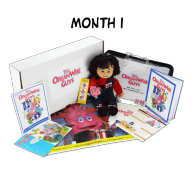The popular TV show, The Biggest Loser, is joining the fight against childhood obesity by inviting three teens to participate this season. On the show we watch the teens face tough exercise routines, learn to eat balanced meals, and create changes in their lifestyles that lead to long-term success. For many parents, this is an inspirational idea. Many of us may even wonder if our child/children would benefit from conducting our own version of “The Biggest Loser.”
A good place to start is an honest conversation with your pediatrician (since studies have shown that 90% of parents perceive that their overweight child is at a healthy weight). Take a good look at the growth charts as a guide. Next assess your lifestyle. Are your meals made up of mostly lean proteins, fruits, vegetables and whole grains? Is your child getting sixty minutes of physical activity each day (including PE, recess, playtime, and extracurricular activities)? Try asking your child specifics about their physical activity every day for a week:
- Did you have recess today? What did you do during that time?
- What did you do in PE today?
- What did you and your friends do when you were playing?
Don’t assume that your child is getting physical activity just because you see these things on his/her schedule. Find out what that really means.
If you discover that your child isn’t very active, come up with a plan to get him or her moving for at least sixty minutes each day. Remember that this doesn’t all have to happen at once. If your child has been very inactive during a cold winter or is a video game fanatic, it will take time to build up his or her energy levels and endurance. Try starting with short bursts of activity and build up. Also, make sure that it’s fun for your child. Your ultimate goal is for your child to establish healthy life habits, not to feel punished with physical activity.
Here are a few ideas to help you get started:
- Add 10 minutes of walking to your daily routine. This is a fun activity that you can do together.
- Schedule a trip to the playground at least once a week, ideally with a friend.
- Try out a new sport or activity. It may take a little time and creativity to find something your child connects with, but continue to try new things.
- Don’t quit too quickly. Ask your child to commit to a certain period of time when trying a new activity. Often people fall in love with an activity as they develop the skills and endurance to really enjoy it.
- Be a good role model. Let your child see you moving!
- Offer appropriate rewards. Don’t let your reward for physical activity be food.
- Children love to track things so create a special sticker chart to log physical activity. They’ll be inspired when they see progress!
If you’re struggling to get in homework and physical activity, try WISERCISE. It’s a great tool that we created that allows you to get 10 minutes of activity while working through a lesson. For example, you can practice your spelling words while being physically activity. That efficiency for a busy parent!

